In college, I wrote for the school newspaper, and my beat was reporting on the Student Government Association (SGA). I often used the minutes from SGA meetings to help me write my article, but I quickly realized that's about all they were being used for—SGA members never read them and usually forgot what they'd discussed in their meetings the next day. And I can't blame them—minutes were kept in a scattered Word Doc and could put a civics professor to sleep.
While minutes are meant to contain the most important records of meetings (that frankly no one would remember otherwise), they can easily become unuseful or outright painful to revisit unless you have a solid framework to work from. That's where a meeting minutes template comes in handy—to ensure you track the most actionable and helpful notes that boards and other teams need to get their work done.
Check out these seven meeting minutes templates and examples for different types of meetings.
Table of contents:
What are meeting minutes?
Meeting minutes document the topics discussed and decisions made in a meeting. They're a bit more formal than personal meeting notes you jot down in a notebook. In theory, you'd review the previous meeting's minutes before the next meeting to refresh your memory on key points, and you'd keep organized records of all past meeting minutes for future reference.
But let's pump the breaks for a second. You shouldn't document the meeting literally minute by minute. Meeting minutes are intended to paint the big picture with three goals in mind:
Outline high-level themes
Document decisions
Track progress on projects and goals
What do meeting minutes include?
Meeting minutes may vary based on the type of meeting they record, but they generally include these key components:
Date
Time
Location (online/in person)
Attendees and absentees
Agenda
Decisions
Action points
Let's say you're in a project planning meeting to discuss developing a new page layout on your website. The meeting minutes should document why the website is being updated, what the team hopes to accomplish by updating the website, who's responsible for each part of the website update, and when the update should be completed.
Later, if Dave from development (who conveniently missed the meeting) has a question about his action items, he can refer back to the meeting minutes.
Why use meeting minutes?
Here are some situations where meeting minutes have quite literally saved the outcome of projects I've worked on:
When there's a disagreement about decisions made in a meeting
When someone is absent from a meeting and needs to catch up on what was discussed
When team members need to be held accountable for their commitments
When a meeting is being audited or reviewed
When a meeting is used to train new employees
But you don't need to start from scratch every time—meeting minutes templates save time while ensuring you're getting all the benefits out of them.
7 meeting minutes templates and examples
Here are seven meeting minutes template examples for nearly every (high-level) meeting format you can think of. Download and customize them to fit your needs.
1. Standard meeting minutes template
Best for: staff meetings, team updates
This template covers the nuts and bolts for most meetings. It works well for recurring team meetings or if you just need a basic structure with an agenda, decisions, and action items to get you going. Key components in this template include:
Meeting title
Date
Time
Location
Attendees
Absentees
Agenda
Decisions
Action items
Next meeting date and time
Wondering where each item in this laundry list of components should go? Take a peek at the meeting minutes example below for inspiration.

2. Detailed meeting minutes template
Best for: project-related meetings, small-to-medium-sized team meetings
A more detailed meeting minutes template can help keep projects on track and hold members of a small team accountable for commitments. In addition to the basic meeting components, a detailed meeting minutes template should also include:
Progress tracking
Project goals and milestones
Roadblocks
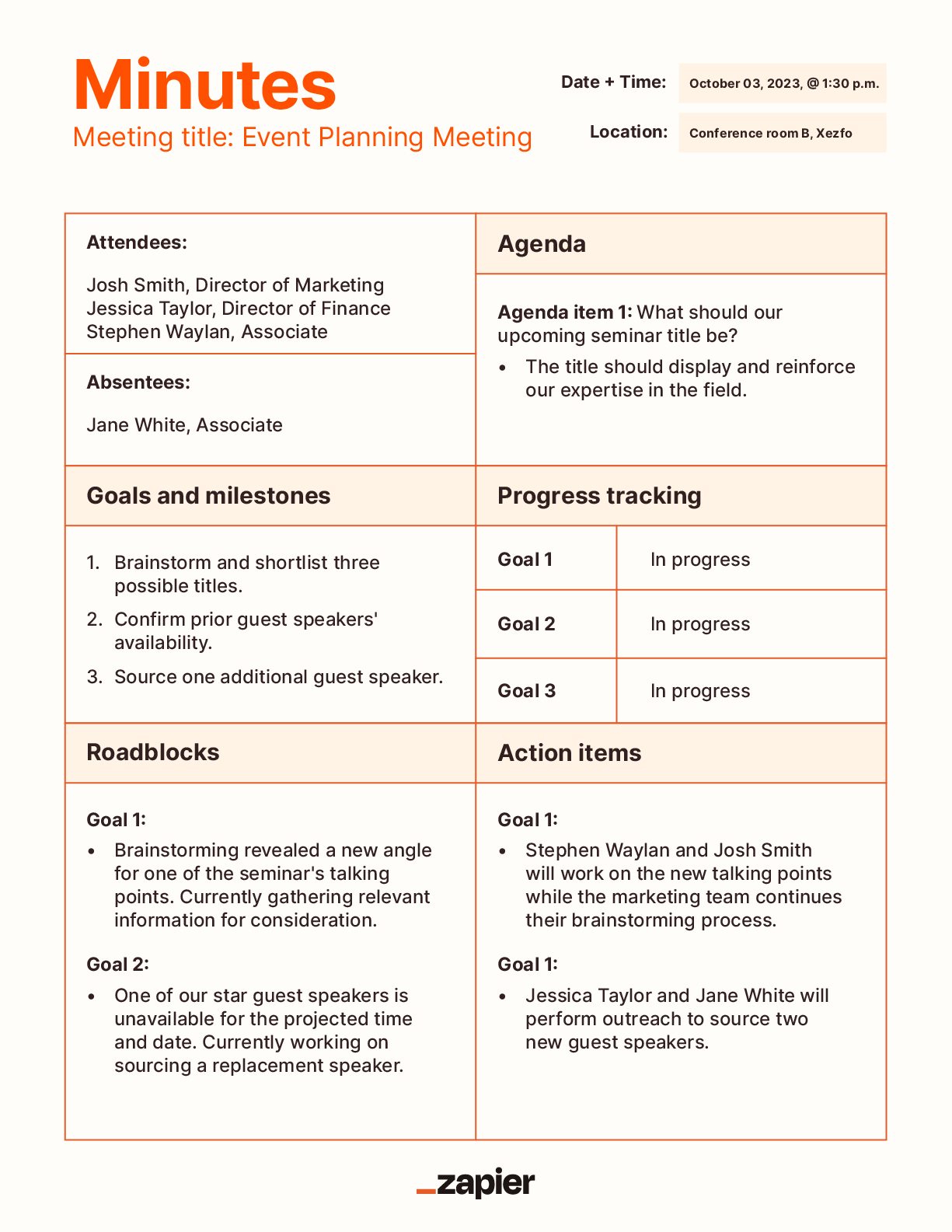
3. Formal meeting minutes template
Best for: executive meetings, board meetings
Have you ever been in a meeting and thought, "Am I underdressed?" That's the kind of meeting this template is for. These meetings have a more structured order of events, like recapping old and new business or voting on new initiatives. A formal meeting minutes template should include space for:
Old business—follow-ups on previous action items
New business—agenda items or new action items
Discussions
Voting records
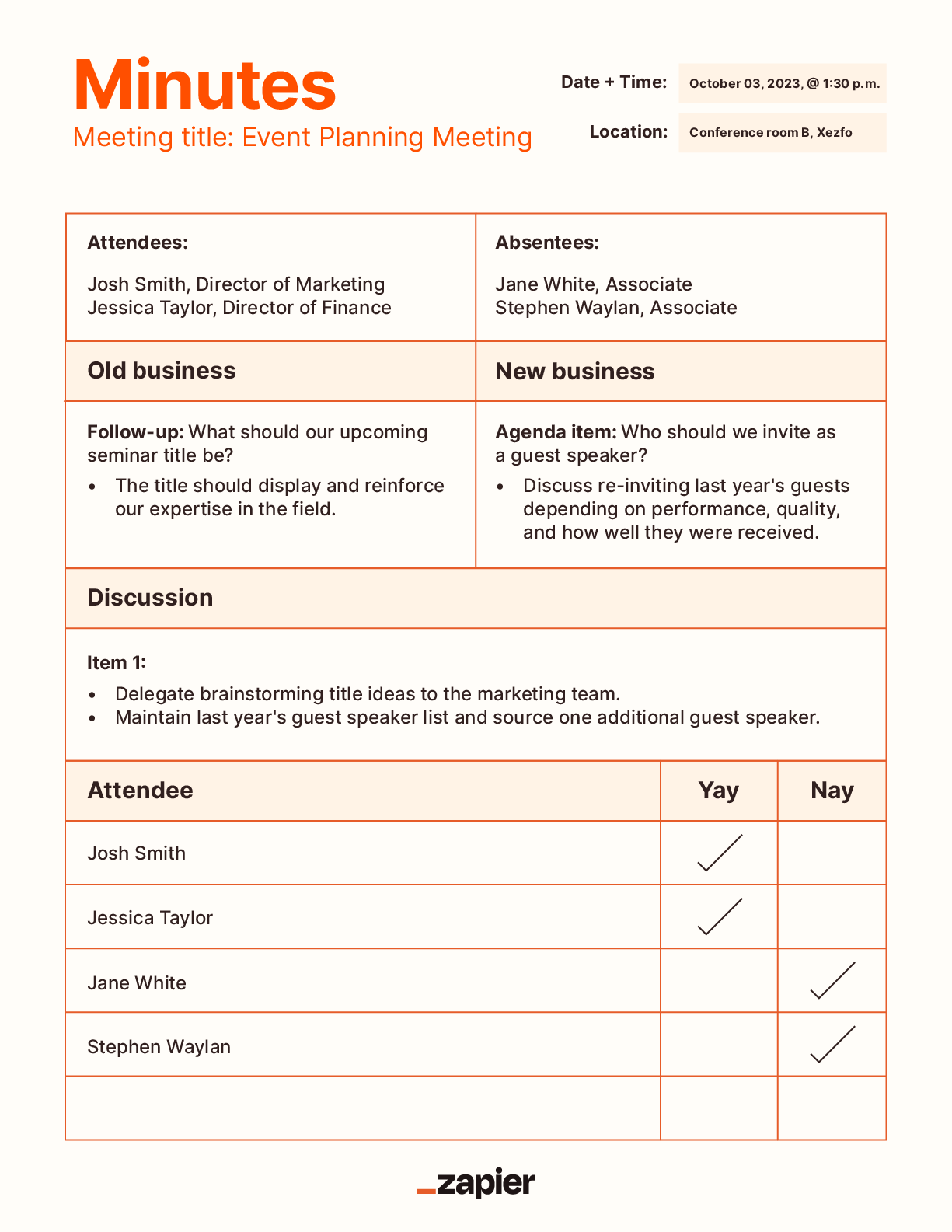
4. Informal meeting minutes template
Best for: team huddles, brainstorms
Need to collaborate or strategize in a more casual, creative environment but don't want to forget all the brilliant ideas you spitball? This type of meeting doesn't necessarily have to be informal, but it can lead to creativity and innovation by allowing teammates to work through half-baked ideas.
A more informal meeting minutes template is perfect for this use case. It's less structured—because how are you going to put your out-of-the-box ideas into a box?—but it still keeps your notes organized with spaces for:
Icebreakers
Creative corner—jot down ideas from brainstorms
Parking lot ideas—ideas that arise during the meeting that aren't relevant to the current discussion but could be considered in the future
Discussions
Shoutouts
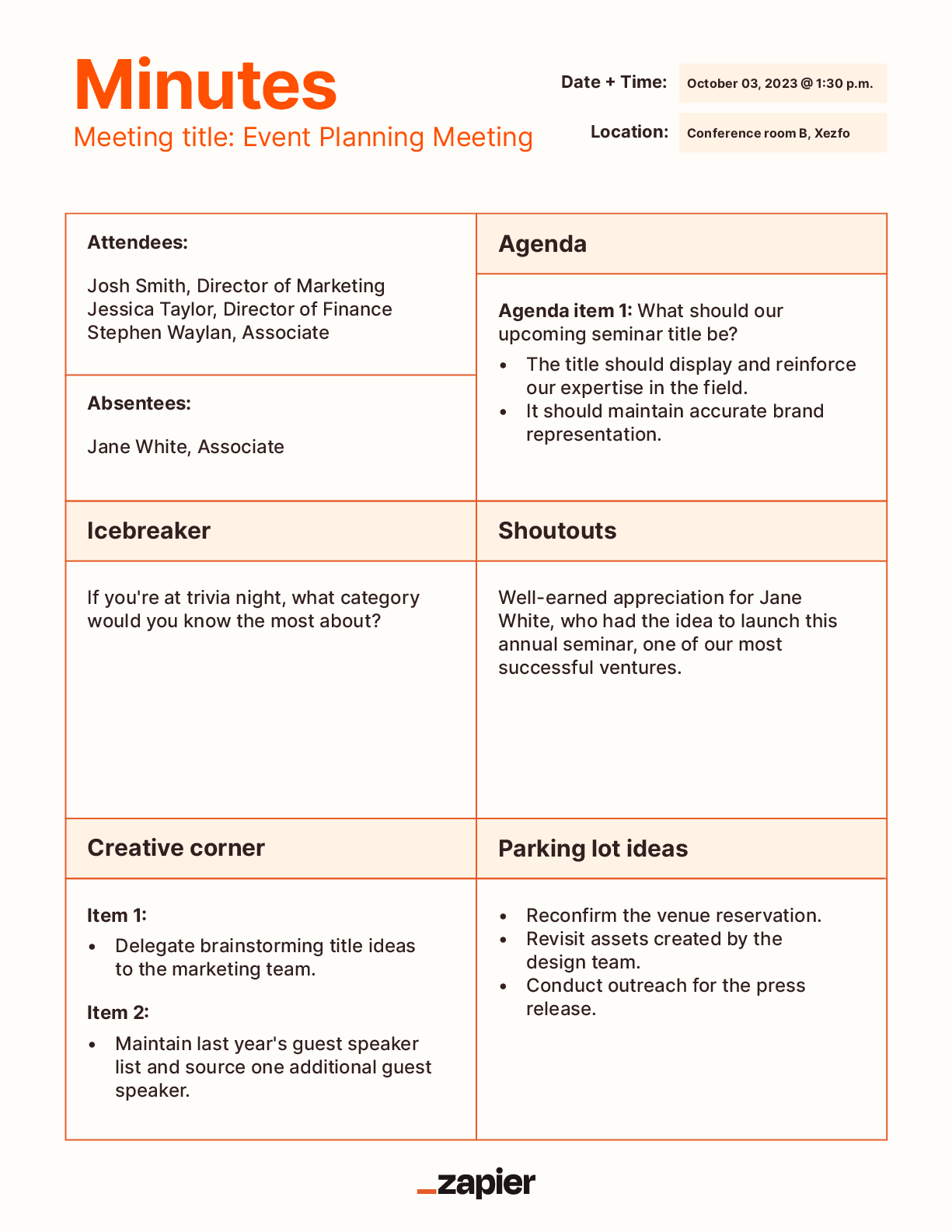
5. Annual meeting minutes template
Best for: annual general meetings
You won't use this template often, but it does help keep a consistent, historical record of your organization's trajectory. To capture key highlights and outcomes of a company's yearly gatherings, use an annual meeting minutes template to keep notes on things like:
State of the organization
Financial review
Strategic initiatives
Recognition and awards
Announcements
Employee questions
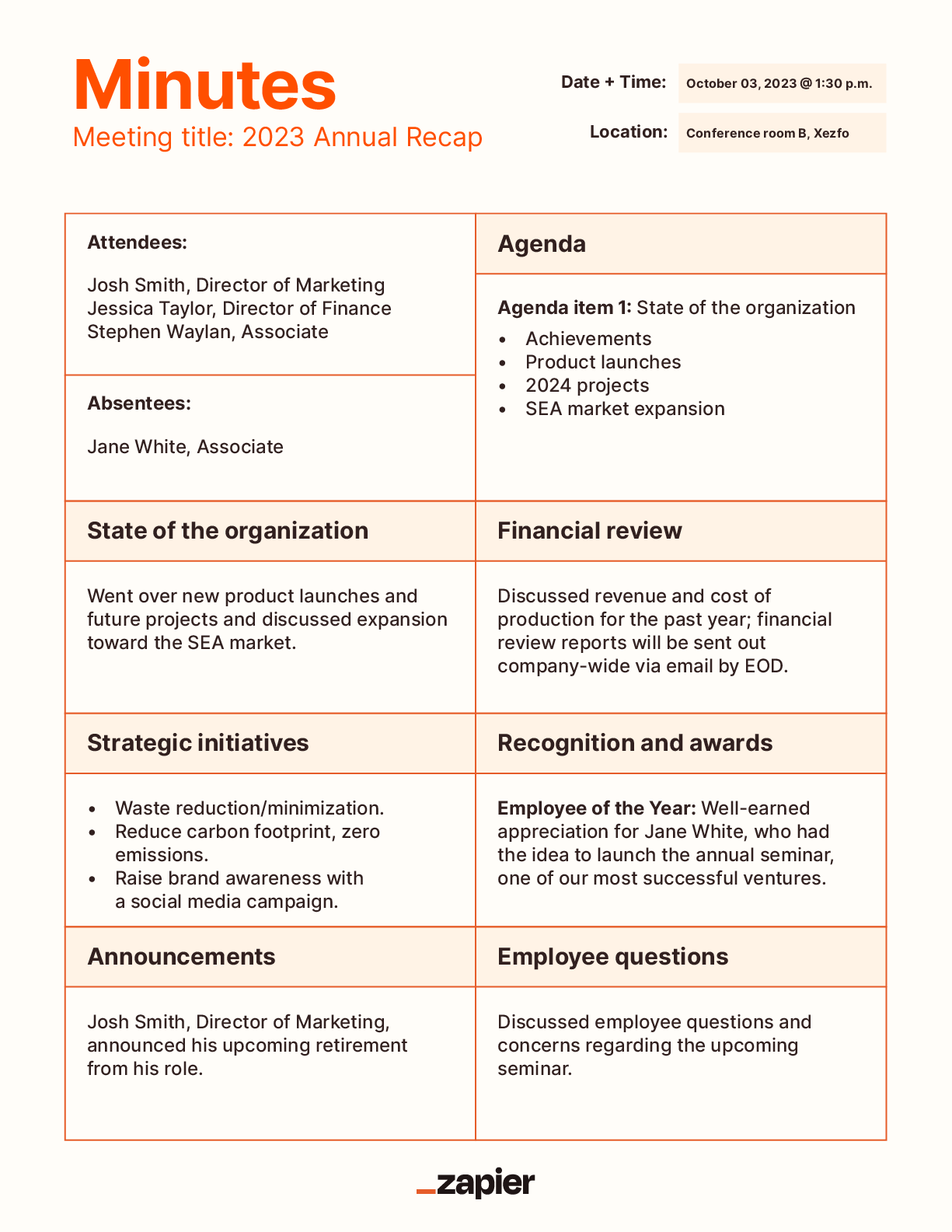
6. Client meeting minutes template
Best for: client meetings
Whether you're in consulting, project management, or any other client-facing role, this template ensures both parties are aligned, expectations are well documented, and progress is effectively tracked. Here's what should be included in a client meeting minutes template:
Agreements
Action items for both sides
Report findings
Client feedback
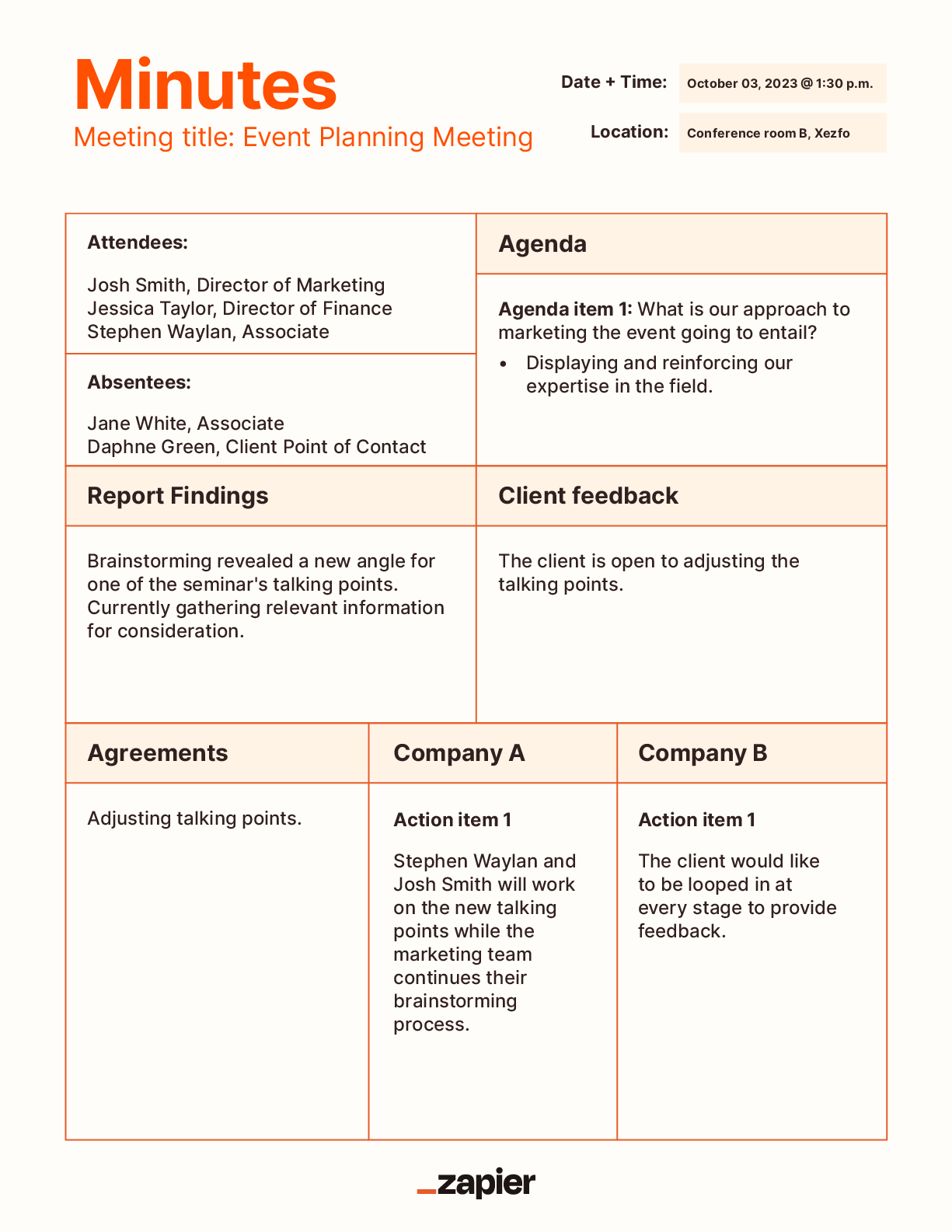
7. Training meeting minutes template
Best for: training sessions
A training meeting minutes template is an invaluable tool for training sessions, workshops, and learning events. It guarantees that key insights and training content are documented for trainees to refer back to, and helps the ongoing improvement of training programs. This type of template should have room for:
Training objectives
Resource links and materials
Key takeaways
Participant feedback
Who to reach out to with additional questions
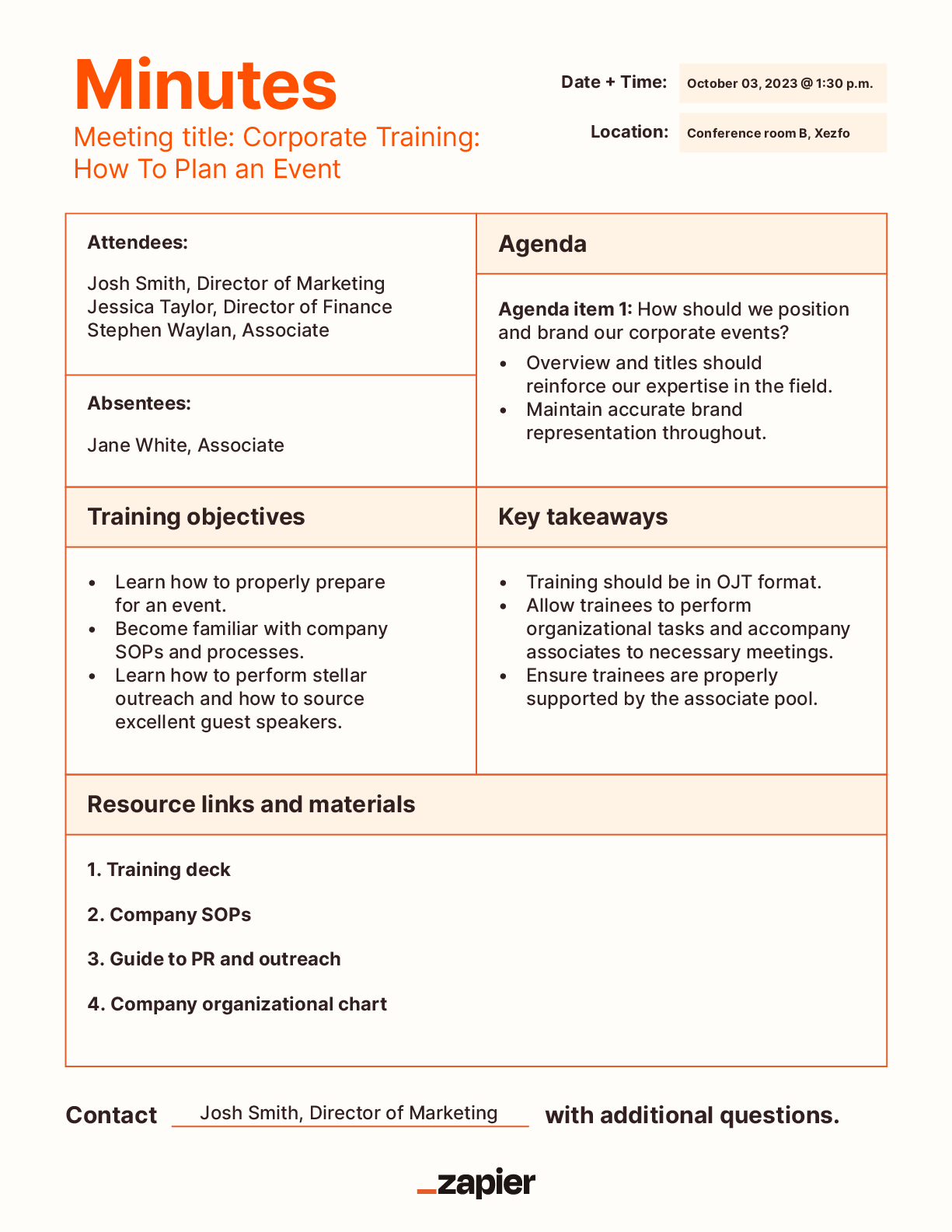
Meeting minutes tips
Using the right template is only the first step in taking effective meeting minutes. Consider these tips when learning how to take meeting minutes (or don't—your supervisors may want you to take the meeting notes forever if you do too good a job):
Avoid transcribing every word. Instead, aim to summarize discussions into key points and action items.
Stay objective. Present discussions and decisions impartially. You may agree with Barbara's eye rolls that this new project is totally useless, but don't let that personal opinion show in your notes.
Consider sharing your screen. For ultimate alignment, you could share your screen while you take notes during the meeting. This way, attendees can verify your notes in real time or chime in with any suggested additions.
Automate meeting minutes
If you want to go a step further, you can use software to do the heavy lifting for you:
Transcription services record meetings and transcribe the audio into text to supplement your meeting minutes. You could include timestamps from the transcription next to key points of your notes for extra context.
AI meeting assistants take things a step further, leveraging AI capabilities to condense the transcription, pull out key takeaways, and produce a list of action items. This method lets you stay present during the meeting while still ensuring accurate and efficient meeting minutes.
You can also automate other routine meeting tasks with Zapier. Learn more about how to automate meeting management, so you can focus on what matters.
Related reading:






